Cannondale updated the Moterra electric mountain bike range in early 2022, adding bigger batteries, tweaking geometry and increasing suspension travel.
The Moterra Neo Carbon LT2 is the cheaper of the two long-travel (that’s what the ‘LT’ stands for) options and, according to Cannondale, is pitched as a hard-charging enduro race bike.
It’s equipped with the latest Bosch Smart System, along with Bosch's large-capacity 750Wh PowerTube battery.
But just how do all those changes stack up on the trail?
Cannondale Moterra Neo Carbon LT2 frame and suspension

The Moterra Neo LT is only offered with a carbon fibre front triangle and Cannondale’s SmartForm C1 alloy rear end – the shorter-travel Moterra Neo has a full alloy frame option.
Cannondale has designed the Moterra Neo LT around a 29in front and 27.5in rear wheel in a bid to maximise backside clearance when things get rowdy.
And that’s exactly what this electric mountain bike is designed to do, which explains why there’s 165mm of rear-wheel travel on tap. This is delivered via a four-bar linkage design, which offers approximately 18 per cent progression (the shock becomes harder to progress the further you get into the bike's travel).
The Moterra Neo LT gets Cannondale’s Proportional Response treatment, which essentially tailors the suspension feel to each frame size. That means, according to Cannondale, leverage ratios, linkages and pivot points will vary across sizes in a bid to give every rider – no matter their size – the same experience on the bike.
There’s space inside the down tube for Bosch’s biggest 750Wh PowerTube battery, which is removable. Alongside the sealed battery cover, Cannondale has bolted an alloy skid plate down under the belly of the bike to help bolster protection that bit further.

A great touch is the robust charging-port flap, complete with locking clasp that keeps it firmly shut and provides protection from the elements. This is far better than floppy rubber equivalents also used on Bosch-powered bikes that tend not to fit properly after some use and allow water and dirt into the port.
As is becoming a common theme, the Moterra’s cables are routed internally, entering through the underside of the stem and passing through the upper-headset assembly.
A protective sleeve sits inside the head tube covering, helping stop the fork steerer from getting worn. The cables are also wrapped in ‘nylon anti-wear wrap’ (from the point of entering the head tube to the first cable clamp within the down tube).
Other details include plenty of rubberised chainstay and seatstay protection to prevent annoying chainslap noise and damage, SRAM’s Universal Derailleur Hanger (UDH) and a bolt-on rear fender. This should help to keep some spray away from linkage pivots and the rear shock.
Cannondale Moterra Neo Carbon LT2 motor and battery

Powering the Moterra Neo Carbon LT2 is the Bosch Smart System, which consists of the Performance Line CX 250W motor and the large-capacity 750Wh PowerTube battery.
The motor in question has 85Nm of torque and four modes (Eco, Tour+, EMTB and Turbo) to choose from.
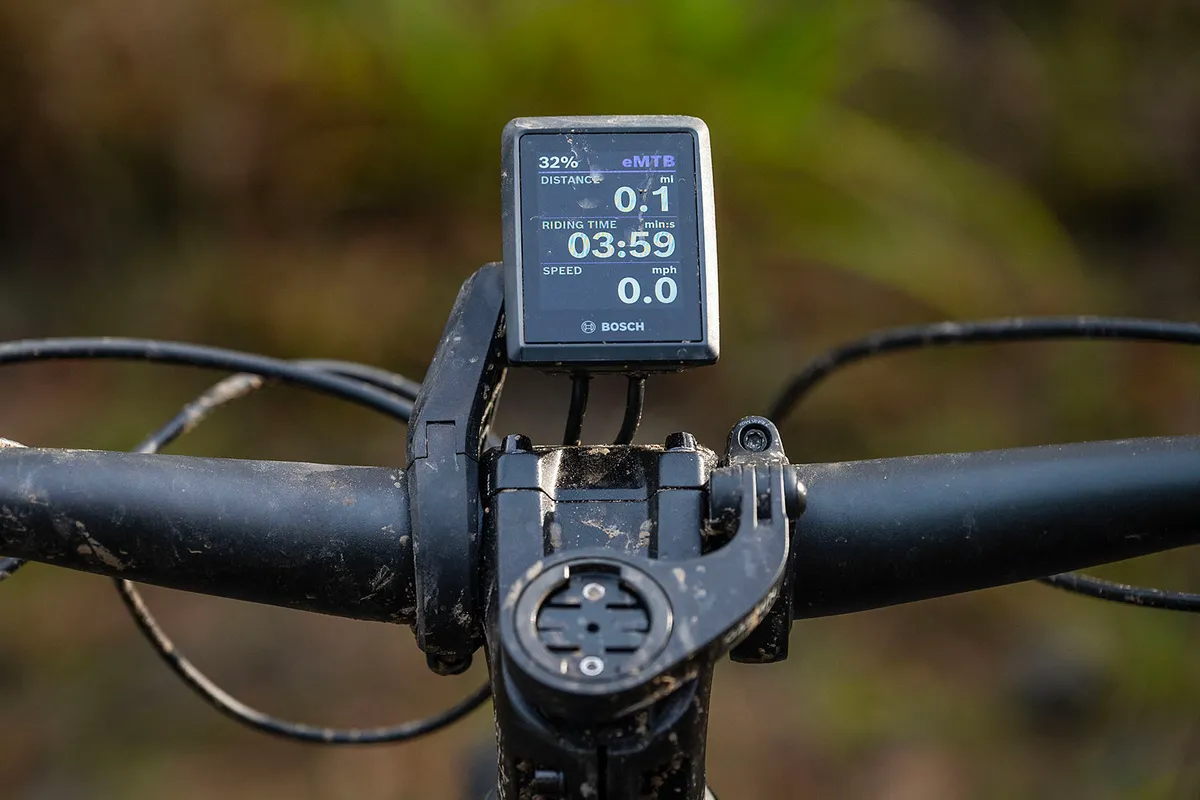
These are controlled via the bar-mounted remote, while the Kiox display (mounted at the centre of and just ahead of the bars) offers up a host of useful information, including remaining battery charge, speed, distance and time.
If you want to tune motor modes, the display or just ensure your bike remains up to date with the latest features, you can download the Bosch eBike Flow app to your phone and connect to your bike via Bluetooth.
Cannondale Moterra Neo Carbon LT2 geometry
In a size medium, the Moterra Neo Carbon LT2 boasts a reach of 446mm (this’ll give you some indication as to how roomy the bike will feel when stood up out of the saddle).
I measured the head angle at a slack 63.9 degrees, while the seat tube angle (with the saddle set to my preferred pedalling height) is steep at 77.5 degrees.
There’s 30mm of bottom bracket drop, placing it 353mm (measured) off the floor.
The effective chainstay length/rear centre doesn’t change across the size range (unlike that of the Cannondale Jekyll – the brand's motor-less enduro machine) and measures a lengthy 452mm.
| | S | M | L | XL |
|---|---|---|---|---|
| Seat angle (degrees) | 76.5 | 76.5 | 76.5 | 76.5 |
| Head angle (degrees) | 64 | 64 | 64 | 64 |
| Chainstay (mm) | 452 | 452 | 452 | 452 |
| Seat tube (mm) | 400 | 460 | 460 | 490 |
| Top tube – horizontal (mm) | 580 | 602 | 634 | 671 |
| Top tube – actual (mm) | 540 | 555 | 585 | 621 |
| Head tube (mm) | 105 | 115 | 125 | 135 |
| Fork offset (mm) | 44 | 44 | 44 | 44 |
| Trail (mm) | 135 | 135 | 135 | 135 |
| Bottom bracket drop (mm) | 11 | 11 | 11 | 11 |
| Bottom bracket height (mm) | 356 | 356 | 356 | 356 |
| Wheelbase (mm) | 1,217 | 1,242 | 1,276 | 1,315 |
| Standover (mm) | 763 | 763 | 767 | 777 |
| Stack (mm) | 623 | 633 | 642 | 651 |
| Reach (mm) | 462 | 556 | 476 | 511 |
Cannondale Moterra Neo Carbon LT2 specification
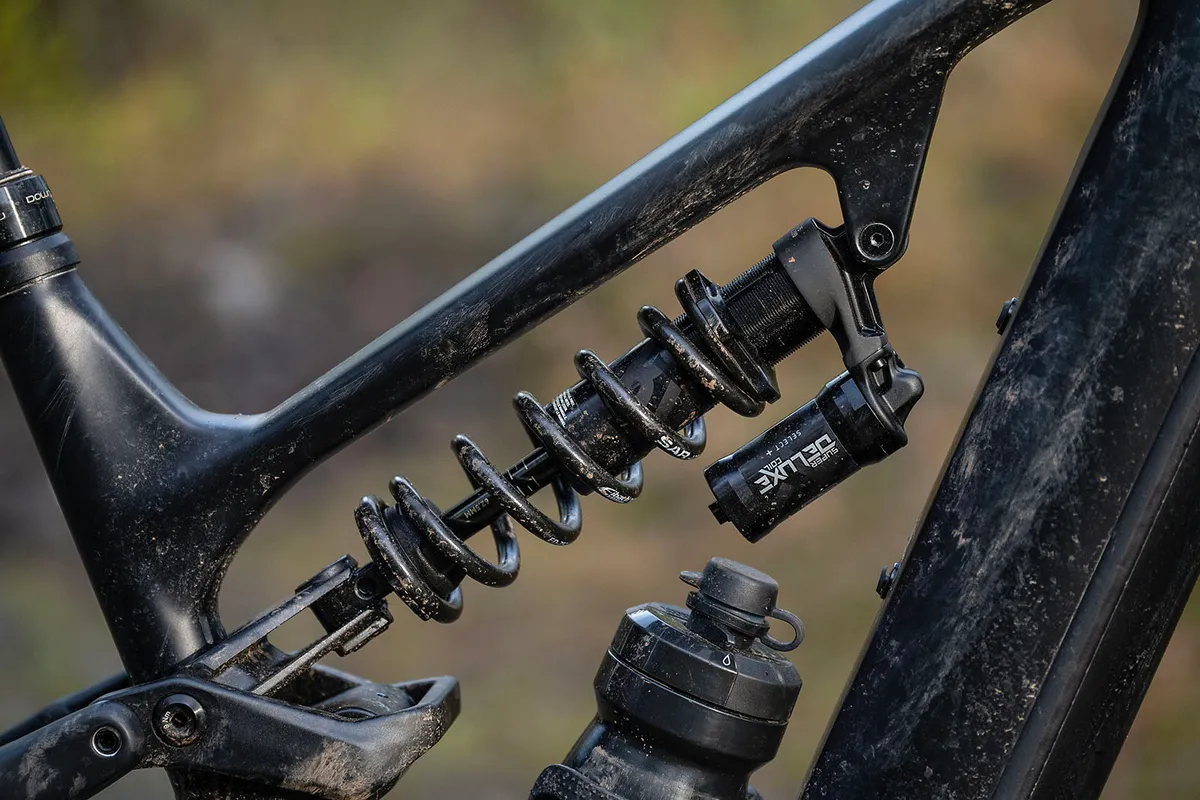
Cannondale only sells the Moterra Neo LT with a coil-sprung shock, in this case a RockShox Deluxe Select+, which includes a small lever that enables you to firm up the shock for more efficient pedalling – not a massive issue on e-MTBs.
The shock is paired with a 170mm-travel RockShox ZEB Select fork, which uses the brand's cheaper RC damper, and not the pricier Charger 3 unit used in the Select+ and Ultimate models.
You still get rebound and low-speed compression adjustment, though.
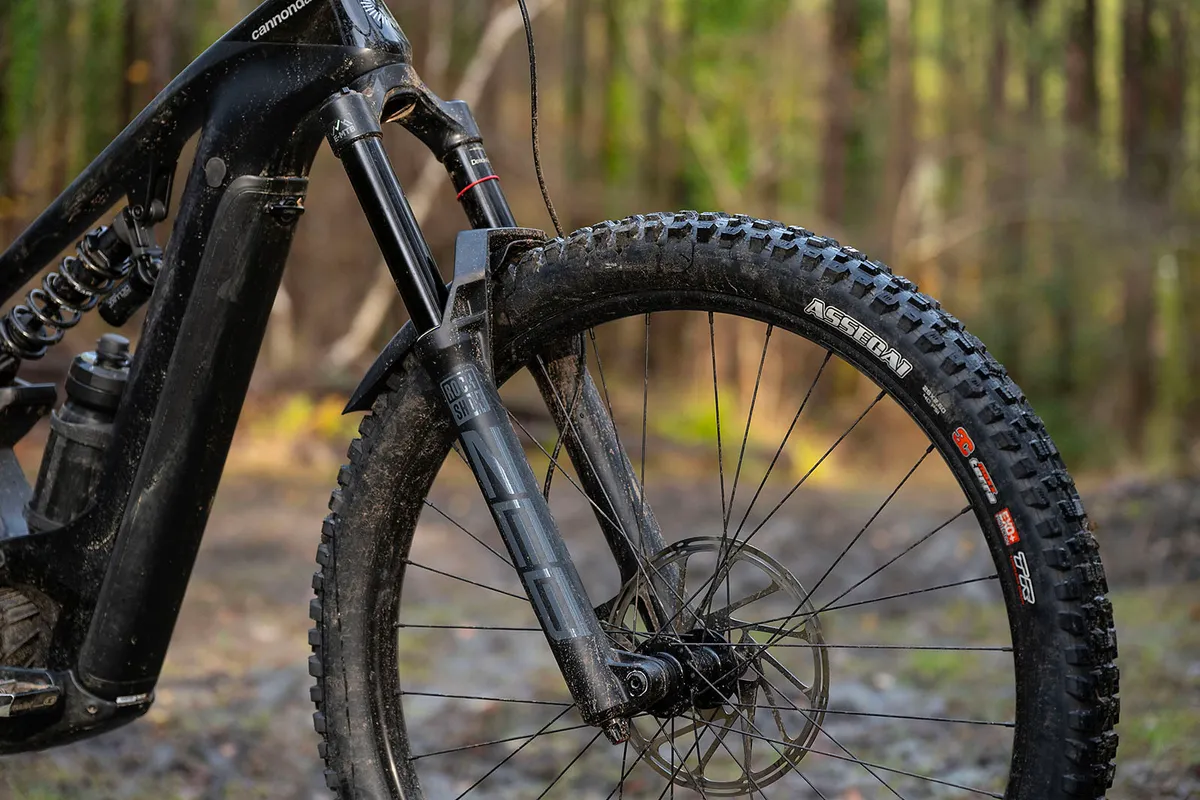
The drivetrain is a (mostly) Shimano affair, with an XT derailleur and SLX shifter, cassette and chain. FSA provides the cranks, which are a stubby 160mm in length.
SRAM Code R brakes, with 220mm front and 200mm rear rotors, take care of stopping duties.
The rims come courtesy of WTB, with the ST i30 TCS hoops laced to a Formula front hub and Shimano MT410 rear. These are wrapped in Maxxis rubber.
Up-front sits an Assegai 3C MaxxTerra with EXO+ casing, while at the rear there’s a Minion DHRII 3C MaxxTerra EXO+.
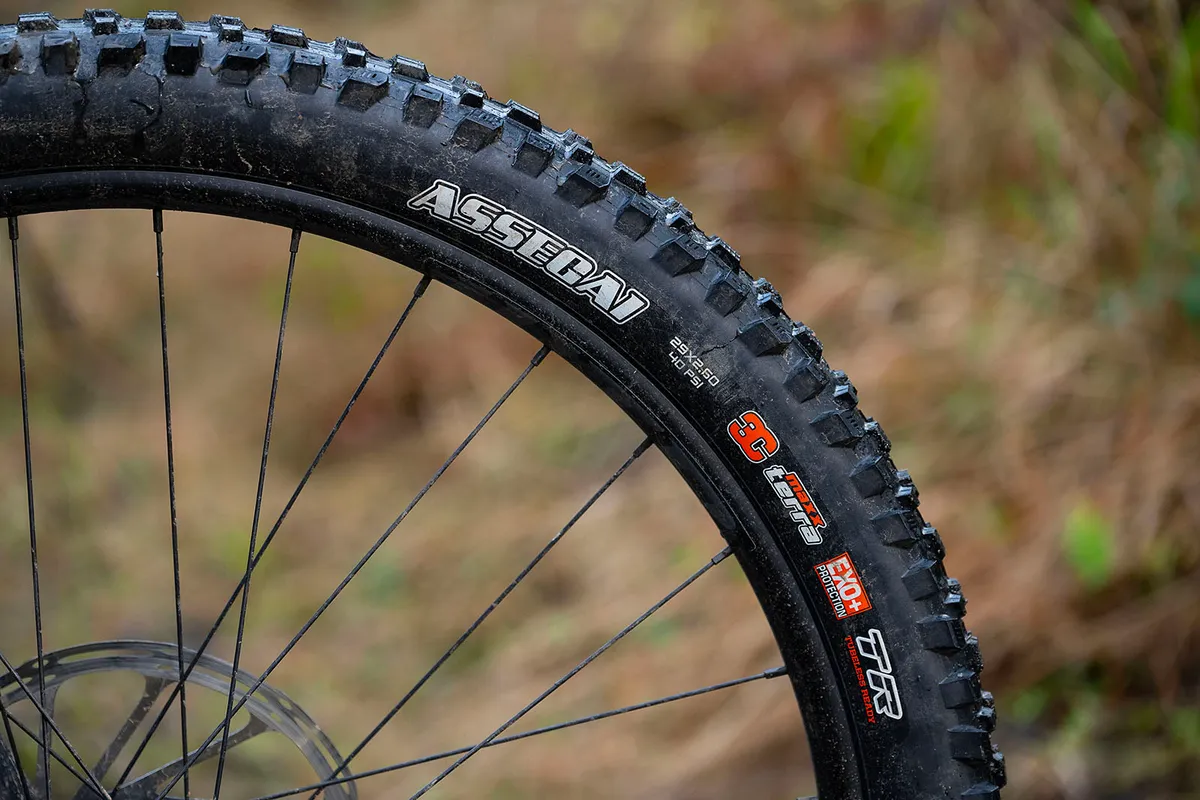
Cannondale provides its own bar, stem and DownLow 150mm-travel (on the medium) dropper post. In-house parts brand Fabric supplies its Scoop Shallow saddle and FunGuy grips.
The medium Moterra Neo Carbon LT2 I had on test weighed 26.2kg without pedals.
Cannondale Moterra Neo Carbon LT2 ride impressions

I rode the Cannondale Moterra Neo Carbon LT2 on a multitude of different terrains, and in varying weather conditions and temperatures.
Alongside laps of battered trail centres, I also tried to ride a wide variety of natural tracks that you’d likely encounter in enduro racing – something this bike is designed for.
That meant a good mix of steep, technical trails at slower speeds, high-paced fast trails littered with rocks and roots, and lots of technical, wooded descents in the mud.
Cannondale Moterra Neo Carbon LT2 setup

There’s no denying it, swapping coil springs on a shock is more complicated than altering air pressure. I had to drop 50lbs to the recommended 400lb spring in order to achieve 30 per cent sag at the rear (for my 68kg weight). I settled on 14 clicks of rebound damping (counted from fully closed).
Up-front, I stuck with the single volume spacer that came as stock and pumped the fork up to 65psi (RockShox recommends going 10psi over what you’d normally run when on an electric mountain bike). To get the fork rebound speed set to my preference, I wound the rebound adjuster out 22 clicks from fully closed.
As well as the coil shock taking a little extra time when it comes to setup, setting bar height – assuming you need to adjust it – isn’t as straightforward as it can be on many bikes.
That’s down to how the cables are routed underneath the stem, in through the steerer spacers and down through the upper-headset assembly.
The guys at Cannondale were quick to point out their bikes sell through shops, which means you’ll have a professional on hand should you need to alter the height of the stem. It means experimenting with bar height once you’re out on the trail isn’t easy, though.
Thankfully, I was more than comfortable with the bar height provided and didn’t need to change anything.
Cannondale Moterra Neo Carbon LT2 climbing performance
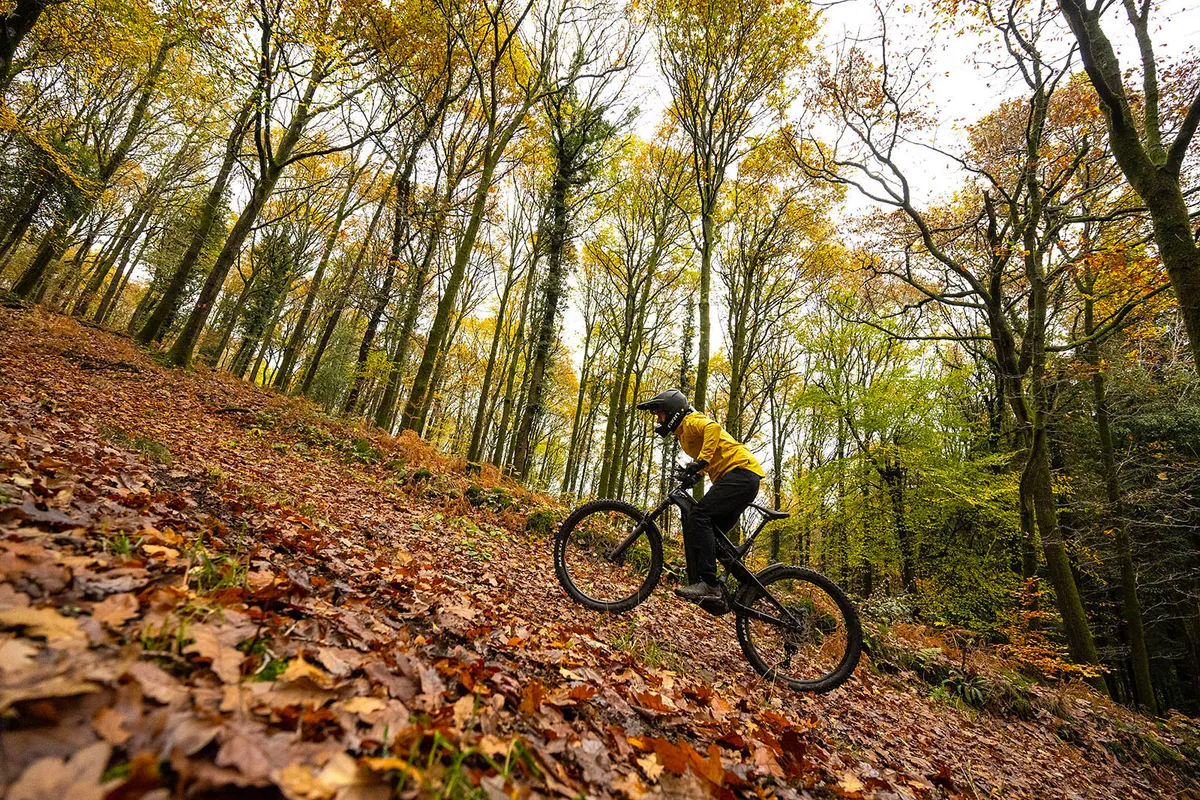
The Moterra Neo Carbon LT2’s seated position feels spot-on when it comes to tackling the climbs. While the effective top tube measurement at 600mm isn’t the most stretched-out, I never felt cramped or uncomfortable when out for hours on end.
It helps that the steep effective seat tube perches you up above the bottom bracket and in a fairly upright position.
The Moterra Neo Carbon LT2 comes into its own when the gradient really steepens. The long chainstay and steep seat tube ensure your weight is better balanced between the wheels and helps to keep the front wheel from lifting, even when navigating awkward, tight uphill hairpins.
There’s a bit of bob from the suspension, but on the whole, the back end of the bike remains pretty calm as you turn the cranks when seated. That means it’s no issue leaving the shock fully open, enabling the back wheel to move up and over obstacles when it needs to and continue to fight for traction when things get a little loose under-wheel.

Bosch’s superb motor delivers the power naturally and smoothly, which is a real plus if attempting particularly technical climbs where, at times, you need to ease off the power or stop pedalling completely to negotiate chunky rock steps or cambered roots.
Here, you’ll also appreciate the overrun produced by the motor (it’ll continue to provide drive to the rear wheel briefly once you stop pedalling). Once you’re used to the feel of this, it really can be used to your advantage.
Cannondale specs short 160mm cranks, though at no point did I struggle with pedals striking the ground, even on stepped, rocky ascents. That’s largely down to the tall bottom bracket. While this might mean you can keep applying the power even when the trail is jagged and rough, it affects how the bike feels through the turns.
In short, though, I was really impressed by how well the Moterra climbed and enjoyed tackling steeper, technical climbs whenever given the chance.
When it comes to range, I managed 37.6km with 1,825m of climbing in the ‘emtb’ mode. I weigh 68kg with kit on.
Cannondale Moterra Neo Carbon LT2 descending performance

While the Moterra Neo Carbon LT2 is clearly an impressive climber, let’s not forget it’s a long-travel monster designed to tackle full-on downhill enduro stages.
Pondering the proportions
Sure, while that longer rear end helps on the climbs, it impacts the playfulness of the Moterra Neo Carbon LT2 somewhat. And when I say playfulness, I mean it takes more effort and energy to loft the front wheel up and over things.
That’s not to say it’s impossible, it just requires more of a pull on the bars, which can become tiring on longer trails. This’ll likely be less of an issue with the proportions of the larger frame sizes, which will alter the balance of the bike and how the rider is positioned between the wheels.

It can, at times, also contribute to the feeling you’re being pitched forward and have too much weight going through your hands on steeper descents.
Upping the fork pressure helped to counter this and better balance the bike (and I couldn’t have raised the bar any higher because I had the maximum number of spacers beneath the stem). This dulls fork sensitivity slightly, but the impact is relatively small.
On the flipside, though, the ride position feels well-centred when carving through turns. There isn’t quite the same ground-hugging connectivity you get with some bikes that have a lower bottom bracket, but hit a turn with commitment and the Moterra Neo Carbon LT2 will rail it at pace with poise and control. That isn’t all down to the numbers, of course.
Superbly sprung

Cannondale has done a great job with the suspension and shock tune. The supple initial touch – something coil-sprung shocks are famed for – really helps the rear tyre bite into the ground and soak up smaller trail imperfections with ease.
However, sink deeper into the shock stroke and there’s more than enough support there, which, despite the stretched-out geometry, ensures there’s more dynamism and liveliness to the ride than you might expect.
This meant I was confident popping gaps or really loading the bike heavily through turns in a bid to maximise exit speed.

It also means there’s something to push against when pumping the bike through trail undulations and generally gives more zip to proceedings than the 26.2kg might suggest.
This enabled me to confidently pump the bike through undulations, load it through turns or pop it over obstacles when I needed to.
On really heavy landings, you can feel the shock hit its bump stop when the entire 165mm of travel has been used up, but at no point did this feel harsh or unpleasant.
Alongside the well-tuned rear suspension, it feels as though Cannondale has done a good job with frame stiffness. At no point did the ride feel harsh, even when battering around rough, well-worn trail centre loops renowned for how jarring they can be.
How does the Cannondale Moterra Neo Carbon LT2 compare to the Nukeproof Megawatt 297 Factory?
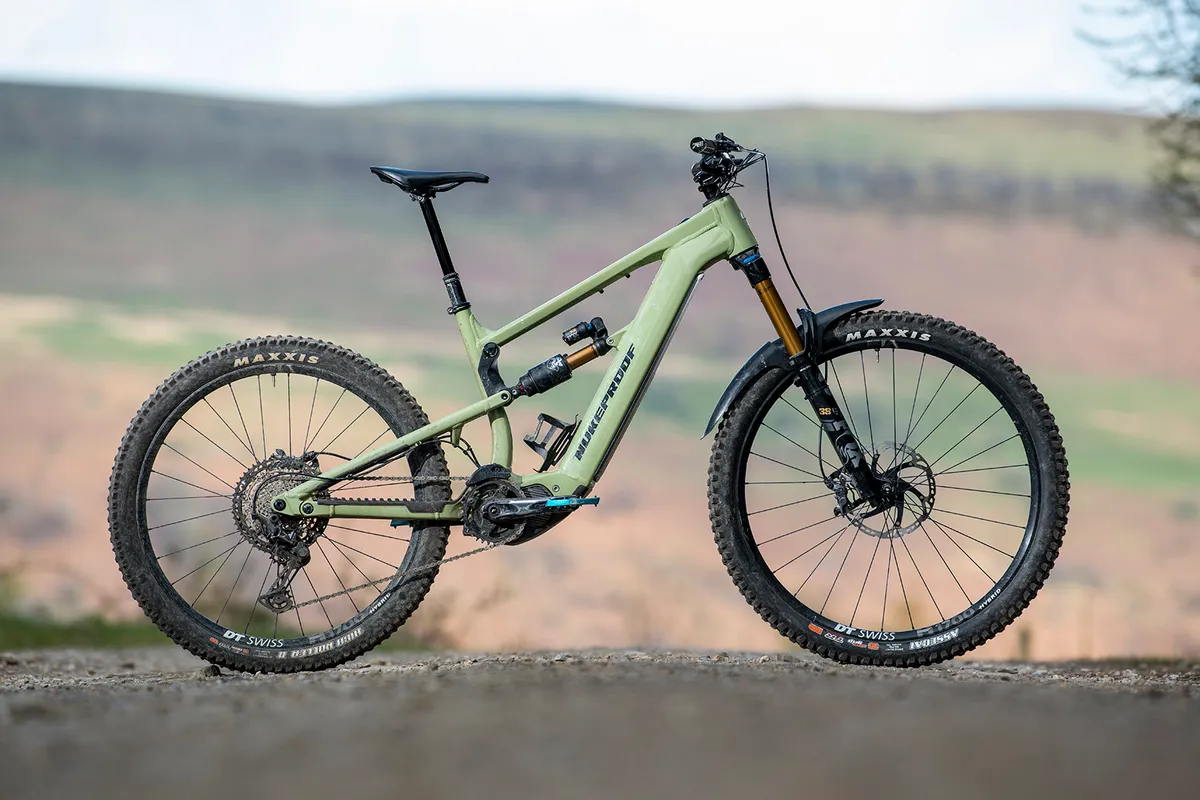
I’ve chosen to compare the Moterra Neo Carbon LT2 to the Nukeproof Megawatt 297 Factory, a bike that shares the same intentions, is closely matched in terms of travel and geometry, and a bike I spent a decent amount of time on.
Both frames are designed around mixed wheel sizes, use a 170mm fork (although the Megawatt boasts 5mm more rear-wheel travel than the Moterra) and are similarly priced.
Both the Nukeproof and Cannondale share almost identical head and seat tube angles, along with closely matched front centres.
The differences then start to creep in, and although they appear quite small, once you add them all up, they have quite an impact on ride feel. For starters, the Nukeproof’s bottom bracket is 10mm lower to the ground, and the chainstays 10mm shorter. There’s also 10mm more reach on the Nukeproof (455mm on the medium).
Next up, the dampers and suspension kinematics. It’s worth pointing out first, that the Nukeproof is £250 cheaper than the Cannondale, but comes with Fox’s Factory-level, top-of-the-line fork and shock, along with a full suite of Shimano XT.
Both bikes are sold via bike shops and are not sold direct to consumer, making this even more impressive.
In terms of feel, Nukeproof’s Megawatt is impressively active and lively on the trail, but the supportive nature of the Cannondale Moterra Neo Carbon LT2 certainly lends itself to aggressive riding and pushing hard.
I’d argue the Cannondale has the edge with the motor choice, because the Bosh unit really is seriously impressive.
Overall, the Nukeproof has the edge. The geometry and suspension pair together to create a livelier ride feel that’s easy to handle on just about anything. The Cannondale, in comparison, feels good, but takes more effort to be ridden in the same way.
Cannondale Moterra Neo Carbon LT2 bottom line

The Cannondale Moterra Neo Carbon LT2 has proven to be a lot of fun on the trail and a great all-rounder once set up correctly.
The smaller frame sizes could benefit from shorter chainstay lengths to perk up the liveliness a little, and the bottom bracket could be a touch lower, but Cannondale has done a good job on the suspension, which really helps elevate the overall performance.
Taller riders might not have the same sensations when it comes to the geometry so, as ever, I’d recommend trying before buying.
Product
| Brand | Cannondale |
| Price | £7250.00 |
| Weight | 26.20kg |
Features
| Fork | RockShox ZEB Select |
| Stem | Cannondale 2 35, 40mm |
| Chain | Shimano SLX |
| Frame | Carbon front triangle, SmartForm C1 alloy rear triangle |
| Motor | Bosch Performance Line CX 250w motor / 750Wh PowerTube battery |
| Tyres | Maxxis Assegai 3C MaxxTerra EXO+ 29x2.6in (fr)/Maxxis Minion DHRII 3C MaxxTerra EXO+ 27.5x2.6in (r) |
| Brakes | SRAM Code R (220mm/200mm rotors) |
| Cranks | FSA Bosch, 160mm |
| Saddle | Fabric Scoop Shallow Sport |
| Wheels | WTB ST i30 TCS rims with a Formula (fr) and Shimano MT410 (r) hubs |
| Shifter | Shimano SLX |
| Cassette | Shimano SLX |
| Seatpost | Cannondale DownLow, 150mm |
| Grips/tape | Fabric FunGuy |
| Handlebar | Cannondale 3 Riser, 800mm |
| Rear shock | RockShox Super Deluxe Select+ Coil |
| Available sizes | S, M, L, XL |
| Rear derailleur | Shimano XT |
